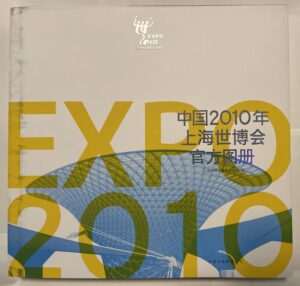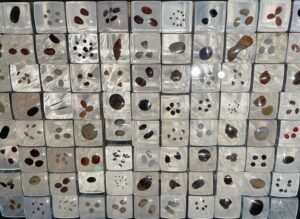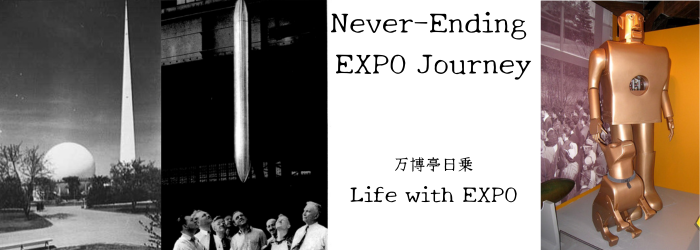“Building Soulfulness, Studio Heatherwick”
“Building Soulfulness, Studio Heatherwick” (Roppongi Mori Art Museum, Tokyo City View), where you can witness overwhelmingly creative works.
Last time, I introduced mainly works that I have visited.
However, the main purpose of my visit this time was, of course, the Expo-related exhibits.
In the sense that the Modern Olympics were born from the World Expo, the design of the 2012 London Olympics Cauldron could be said to be related to the World Expo.
However, my main focus this time is the “Shanghai Expo UK Pavilion“.
2010 Shanghai Expo
Shanghai Expo was held in 2010.
This Expo was the second Registered Exposition held every five years after the 2005 Aichi Expo.
The theme was “Better City, Better Life.”
The exhibition was held for 184 days from May 1, 2010 to October 31, 2010.
The number of visitors was 73,084,400, the highest in the history of the Expo (the previous highest was 64,218,770 at the Osaka Expo in 1970).
There were 190 participating countries and 56 international organizations, the largest number in Expo’s history.
It also received the title of “the first World Expo held in a ‘developing country'”.
The maximum number of visitors in a day was 1,032,700, which is the highest ever in the Expo history (the previous record was 835,832 at the 1970 Osaka Expo).
It was truly the largest expo in the history of the expo and the largest number of on-parade expos.

2010上海万博遠景
The Distant View of 2010 Shanghai Expo SIte
The UK Pavilion stood out at this unprecedented Expo.
It is a design that you will never forget once you see it.
I visited the Shanghai World Expo often because I was in charge of it for work, and visited almost all the pavilions.
However, no matter how many times I look at it now, this pavilion still stands out.

2010年上海万博英国館
UK Pavilion, 2010 Shanghai Expo
ヘザウィック・スタジオ《エアロ》
この写真は「クリエイティブ・コモンズ表示 – 非営利 – 改変禁止 4.0 国際」ライセンスの下で許諾されています。

2010年上海万博 英国館
UK Pavilion, 2010 Shanghai Expo
ヘザウィック・スタジオ《エアロ》
この写真は「クリエイティブ・コモンズ表示 – 非営利 – 改変禁止 4.0 国際」ライセンスの下で許諾されています。
“Seed Cathedral”
In the thick booklet titled 「中国2010年上海世博会官方图册」(2010 Shanghai Expo Official Catalogue) edited by the Shanghai World Expo Secretariat and Coordination Bureau, which I have treasured in Banpaku-tei (Expo-Arbor), “UK Pavilion” is described as follows;

中国2010年上海世博会官方图册
2010 Shanghai Expo Official Catalogue
*
主題 传承经典,铸就未来
位置 C
国家館日 2010年9月8日
*
By 「主題」, it means the “theme” of the British Pavilion.
「传承经典,铸就未来」’s meaning is “Building on the Past, Shaping Our Future.”
「位置 C 」means, ‘The location of the pavilion is in the “C” zone, which used to be the zone of European national pavilions’,
And 「国家館日 2010年9月8日」means that the National Day is September 8th.
A Chinese commentary follows. I try to translate it into English. (The original Chinese text is put at the end of this post.)
*
The Pavilion aims to draw attention to the role of nature and to consider how tradition and nature can be used to solve the social, economic and environmental challenges posed by the future of the city.
The dandelion-like shape and unique creativity of the Pavilion’s core ‘Seed Cathedral’ is also a clever interpretation of the theme.
The exterior is covered with more than 60,000 acrylic tentacles that stretch and sway everywhere.
During the day, the tentacles transmit natural light like optical fibers to illuminate the interior, and at night, the light source embedded in the tentacles illuminates the entire building, creating a unique futuristic city that draws people’s attention.
The contents of the pavilion include “Green City”, “Open City”, “Seed Cathedral”, “Vibrant City”, “Open Park” and so on.
‘Green City’ presents a fusion of cityscapes, green vegetation, aquascapes and architecture in four major capital cities in the UK. The ‘Seed Cathedral’ showcases seeds of various types and shapes extracted from the Millennium Seed Bank at Kew Gardens, UK.
‘Vibrant City’ displays many living and imaginary plants, expressing British creativity and high technological prowess, imagining a future city that develops in harmony with nature, is rich in technological innovation, and becomes prosperous. ”
*
On the other hand, according to the explanation panel of this exhibition, it says as follows.
*
The studio was selected to design the UK pavilion for the 2010 World Expo in Shanghai. One of the brief’s main requirements was to make a building that would place in the top five pavilions. To solve this challenge with a limited budget and a site the scale of a football pitch, the studio created a singular building with a striking exterior that would communicate its content and provide respite from the sensory overload of the Expo.
Rather than trying to show all of Britain’s best known assets, the scheme focused on the UK’s pioneering history of urban parks and gardens, as well as its botanical research heritage and took inspiration from Kew Garden’s Millennium Seed Bank, one of the largest plant conservation programs in the world. The studio designed a building with a kinetic exterior that would sway gently in the breeze, almost like long grass buffeted by wind. Developed according to computer modelling and on-site adjustments, its flexible ‘hairs’ were arranged around a central cube. Composed of 60,000 acrylic rods, each 7.5 meter-long, the rods transmitted light, illuminating the interior and the 250,000 seeds embedded in the rod tips.

2010年上海万博英国館 種の納められた先端部分(アクリル・種)
2010 Shanghai Expo UK Pavilion Seed Tips Acrylic and seed
ヘザウィック・スタジオ《エアロ》
この写真は「クリエイティブ・コモンズ表示 – 非営利 – 改変禁止 4.0 国際」ライセンスの下で許諾されています。

2010年上海万博英国館 種の納められた先端部分(アクリル・種)
2010 Shanghai Expo UK Pavilion Seed Tips Acrylic and seed
ヘザウィック・スタジオ《エアロ》
この写真は「クリエイティブ・コモンズ表示 – 非営利 – 改変禁止 4.0 国際」ライセンスの下で許諾されています。
Surrounded by a landscape like a crumpled piece of paper, the inclined surfaces framed the “Seed Cathedral” and housed facilities, as well giving visitors a place to relax. The open public space acted like a village green and emphasized the theme of the UK pavilion itself.

英国館内部
Inside of UK Pavilion
ヘザウィック・スタジオ《エアロ》
この写真は「クリエイティブ・コモンズ表示 – 非営利 – 改変禁止 4.0 国際」ライセンスの下で許諾されています。
Of more than 200 other entries, the pavilion won the Expo’s top prize, the gold medal for Pavilion Design, and was visited by over 7 million people during the Expo.
*
After all, the 「中国2010年上海世博会官方图册」(2010 Shanghai Expo Official Catalogue) mainly explains the purpose and structure of this pavilion, as it should as a catalog of the Expo, and the explanation of this exhibition panel mainly explains the pavilion design.
Also, regarding the last part, ” the pavilion won the Expo’s top prize, the gold medal for Pavilion Design,” the website of the BIE (Bureau International des Expositions) states as follows;
*
Pavilion type
Self-Built Pavilion
Theme
Building on the Past, Shaping Our Future
Architect(s)
Heatherwick Studio
Size (m2)
6,000
Location
Zone C
Awards
Gold – “Pavilion Design” category – Pavilions Category A
National Day
08 Sept 2010
*
So, it won the Gold Award in the “Pavilion Design” category of “Pavilion Category A” (large pavilion).
In this exhibition, in addition to sketches, photographs, models, and videos of the British Pavilion, the “Seed Tips, Acrylic and Seeds” of fibers that actually contain plant seeds were also on display, renewing the excitement of visiting the British Pavilion in 2010.
From my point of view, who saw almost all of the pavilions at the Shanghai Expo, the concept and the pavilion design of UK Pavilion are distinct from other pavilions. It can be said that it was the unprecedented pavilion in the 160 year of history of World Expo.
If you are interested in the British pavilion at Expo 2010 Shanghai, I highly recommend that you take this opportunity to visit this wonderful exhibition.
By the way, there is a video of Thomas Heatherwick himself talking about this British pavilion in a TED talk. If you are interested, please click the link. (From around 7 minutes and 30 seconds.)
* The original Chinese text on UK Pavilion of 2010 Shanghai Expo Official Catalogue(「中国2010年上海世博会官方图册」)
英国馆旨在引导人们关注自然所扮演的角色,并思索如何利用传统和自然来解决社会、经济和环境给城市未来带来的挑战。
展馆核心“种子圣殿”蒲公英般的外形和独特的创意也巧妙地演绎了主题。
外部布满6万余根向各处伸展, 摇曳的亚克力杆触须,白天,触须像光纤一样传导自然光线,提供内部照明:夜间,触须内置的光源照亮整个建筑,成为一座奇特而夺目的未来之城。
展馆内容包括“绿色城市”、“开放城市”、“种子圣殿”、“活力城市”和“开放公园”等。
”绿色城市”展示了英国四大首府的城市景观,绿色植物、水景与建筑融为一体:“种子圣殿”展示从英国基尤千年种子银行提取的不同种类、形态各异的种子:“活力城市”陈列了许多活体植物和构想中的植物,展现了英国的创造力和高新技术,设想未来的城市在与自然的和谐交融中发展,在科技创新中充实和丰富。



